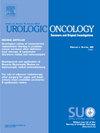肿瘤直径-前列腺体积比在预测磁共振成像/经直肠超声融合活检结果中的应用。
IF 2.4
3区 医学
Q3 ONCOLOGY
Urologic Oncology-seminars and Original Investigations
Pub Date : 2025-04-15
DOI:10.1016/j.urolonc.2025.03.021
引用次数: 0
摘要
目的:评估肿瘤直径与前列腺体积比(TD/PV)在磁共振成像(MRI) /经直肠超声(TRUS)融合靶向活检中预测前列腺癌(PCa)和临床意义(cs) -PCa的影响,基于前列腺成像报告和数据系统(PI-RADS)的MRI结果。材料和方法:回顾性分析2017年至2023年间因PI-RADS 2.1版本3-5类病变接受MRI/TRUS融合靶向活检的患者。TD/PV由肿瘤直径除以前列腺总体积计算。csPCa定义为Gleason评分≥3 + 4。单变量和多变量逻辑回归分析用于PCa和csPCa的预测模态图。构建受试者工作特征曲线,用曲线下面积(AUC)评价各因素的预测能力。结果:共分析565例患者;预测前列腺特异性抗原(PSA)、肿瘤直径、PSA密度、PI-RADS的AUC (AUC: 0.840, P < 0.05)和csPCa的AUC (AUC: 0.819, P < 0.05)显著优于预测前列腺特异性抗原(PSA)、肿瘤直径、PSA密度和PI-RADS的AUC (AUC: 0.819, P < 0.05)。多变量分析显示,TD/PV是MRI/TRUS融合活检中PCa和csPCa的重要预测因素(P < 0.05)。构建了结合TD/PV和PI-RADS分类的预测图,其预测PCa和csPCa的auc分别为0.861和0.845。结论:在本回顾性分析中,当TD/PV与PI-RADS分类相结合时,MRI/TRUS融合活检中PCa和csPCa的预测得到改善。本文章由计算机程序翻译,如有差异,请以英文原文为准。
Utility of tumor diameter-to-prostate volume ratio for predicting the outcome of magnetic resonance imaging/transrectal ultrasound fusion-targeted biopsy
Objectives
To assess the impact of the tumor diameter-to-prostate volume ratio (TD/PV) on predicting prostate cancer (PCa) and clinically significant (cs) -PCa in magnetic resonance imaging (MRI) /transrectal ultrasound (TRUS) fusion-targeted biopsy based on prostate imaging-reporting and data system (PI-RADS) findings in MRI.
Materials and methods
Patients who underwent MRI/TRUS fusion-targeted biopsy for PI-RADS version 2.1 categories 3–5 lesions between 2017 and 2023 were retrospectively reviewed. TD/PV was calculated by dividing the tumor diameter by the total prostate volume. csPCa was defined as a Gleason score of ≥ 3 + 4. Univariable and multivariable logistic regression analyses were used to develop predictive nomograms for PCa and csPCa. A receiver operating characteristic curve was constructed to evaluate the predictive ability of the factors using the area under the curve (AUC).
Results
A total of 565 patients were analyzed; the AUC of TD/PV was significantly superior to those of the prostate-specific antigen (PSA), tumor diameter, PSA density, and PI-RADS for predicting PCa (AUC: 0.840, P < 0.05) and csPCa (AUC: 0.819, P < 0.05). Multivariable analyses showed that TD/PV is a significant predictive factor for PCa and csPCa in MRI/TRUS fusion-targeted biopsy (P < 0.05). The predictive nomograms combining TD/PV and PI-RADS category were constructed and their AUCs for predicting PCa and csPCa were 0.861 and 0.845, respectively.
Conclusions
In this retrospective analysis, prediction of PCa and csPCa on MRI/TRUS fusion-targeted biopsy was improved when TD/PV was combined with PI-RADS category.
求助全文
通过发布文献求助,成功后即可免费获取论文全文。
去求助
来源期刊
CiteScore
4.80
自引率
3.70%
发文量
297
审稿时长
7.6 weeks
期刊介绍:
Urologic Oncology: Seminars and Original Investigations is the official journal of the Society of Urologic Oncology. The journal publishes practical, timely, and relevant clinical and basic science research articles which address any aspect of urologic oncology. Each issue comprises original research, news and topics, survey articles providing short commentaries on other important articles in the urologic oncology literature, and reviews including an in-depth Seminar examining a specific clinical dilemma. The journal periodically publishes supplement issues devoted to areas of current interest to the urologic oncology community. Articles published are of interest to researchers and the clinicians involved in the practice of urologic oncology including urologists, oncologists, and radiologists.

 求助内容:
求助内容: 应助结果提醒方式:
应助结果提醒方式:


